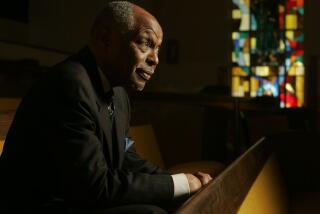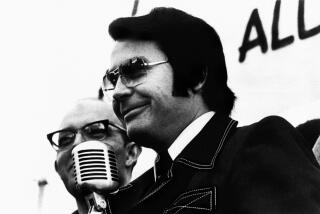The Rise and Fall of a Church and Its Founder
From his first trip to Hollywood in 1947 until his death 39 years later at 93, Herbert W. Armstrong’s career as a religious entrepreneur was one of the most spectacular Southern California had ever seen. In his prime--and for years beyond--he combined radio flair, marketing prowess and a quirky theological smorgasbord to build a luxuriously appointed 50-acre Pasadena campus. Its capstone was the $11-million Ambassador Auditorium, whose acoustics were praised and whose stage attracted the likes of Artur Rubenstein, Luciano Pavarotti and the Vienna Symphony--as well as Bob Hope and Bing Crosby.
The denomination Armstrong started, known as the Worldwide Church of God, had about 120,000 members at its peak, with a top annual income exceeding $200 million. Fifteen years after Armstrong’s death in 1986, the church--of which I was a member from 1975 to 1979 and whose journey I have observed closely since--has transformed itself dramatically. Its renowned auditorium no longer hosts concerts or comedians; the artistic programming went away six years ago. Ambassador College, which achieved accreditation in the late 1980s, no longer exists. And no church voice “cries out in the wilderness” blanketing the country’s radio or TV stations, as the man who openly referred to himself as “Christ’s end-time apostle” once did.
In “The Liberation of the Worldwide Church of God,” J. Michael Feazell, a leading church figure and executive editor of the church’s magazine The Plain Truth, chronicles the rise and fall of both the church and the man. This behind-the-scenes view of a religious group shedding almost every doctrine it once clung to is a story perhaps without parallel in American religious history. Imagine Oral Roberts giving up on faith healing or the pope renouncing Petrine succession. Shortly after Armstrong died, Feazell and the church leadership began reexamining the doctrines once held inviolable. In almost every instance they discovered that Armstrong’s beliefs were based on the leader’s exceptionally poor scholarship. A high school dropout and admittedly failed businessman, Armstrong developed an eclectic, self-taught theology that was his badge of honor--and ultimately a heavy cross for the church to bear.
Among his beliefs that came under scrutiny after his death was his insistence that one is not “born again” after accepting Christ, but rather “begotten” with a chance to succeed or be “spiritually aborted” as a believer. Church leaders felt that it was built on a faulty translation of one Greek word in the King James version of the New Testament. The long-held church belief that relying on medicine for healing was an affront to God’s power is dramatically told by Feazell, who recounts the story of his own internal struggle when his young son contracted pneumonia.
But two doctrinal pillars provoked the greatest rebellion when toppled. The first was the belief that the United States and Britain were populated chiefly by descendants of two “lost tribes” of ancient Israel and that the two nations were identifiable in biblical prophecy.
Then the church reversed its long-standing insistence on observing a seventh-day (Saturday) Sabbath and biblical holy days such as Passover, the Day of Atonement and the Feast of Tabernacles. Such days may be observed, the church declared, but a person could also go to church on Sunday and celebrate Christmas and Easter and still be numbered among the faithful--something Armstrong would never have allowed.
Feazell tells how the church had to deal with anger among the membership when these theological pillars were dismantled. An evolution in eschatology might have been palatable, but the church’s change on holy days proved way too much for many to accept. The departures fractured the church, ruptured friendships and family relationships, and sent the church’s finances plunging into red ink.
Yet Feazell defends the moves as necessary to bring Christian freedom to a group hidebound by what he called a legalistic observance of nonessential doctrines. Through the doctrinal review process--and his master’s studies at Azusa Pacific University, to which Feazell has since added a doctorate--he found that the real basis of a Christian’s right standing with God is a right relationship with Jesus, not outward observances.
It’s saddening to read Feazell’s account of how some church ministers didn’t grasp the fine details of his and others’ reformed theology, although others warmed to its message. At the same time, Feazell’s sustained inveighing against seventh-day Sabbath-keeping could offend and confuse those for whom the concept is an important, restorative part of their faith.
But the story of the church’s doctrinal growth and maturation remains--much like the tale of Armstrong himself--almost unique in the history of American-born religions.
More to Read
The biggest entertainment stories
Get our big stories about Hollywood, film, television, music, arts, culture and more right in your inbox as soon as they publish.
You may occasionally receive promotional content from the Los Angeles Times.










